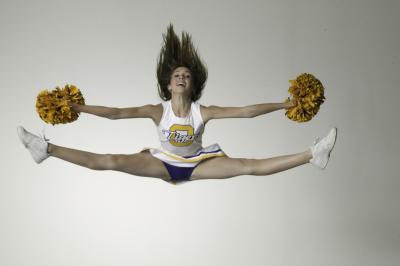Jumps
- Toe-Touch
- In this jump, the legs are straddled and straight, parallel to the ground, toes pointed, knees are back, and the arms in a T motion. Despite its name, you do not touch your toes during a toe touch, you reach out farther in front of your legs. keep your back straight and bring your legs up to you. This is the most common jump.

- Double Hook
- A jump where the legs are in the "cheer sit" position.
- Herkie
- Named for Lawrence R. Herkimer, the founder of the National Cheerleader's Association, this jump is similar to a side-hurdler, except that instead of both arms being in a "T" motion, both arms are opposite of what the leg beneath them is doing. Example of this would be the straight arm would be on the side of the bent leg, and the bent arm is on the side of the straight leg. One other variation of this includes the bent leg is pointing straight down, instead of out like the side-hurdler. The jump is speculated to have been invented because Herkie wasn't able to do an actual side-hurdler.
-
-
-
-
-
-
- Double Nine
-
- A jump similar to a pike except one leg and one arm are bent in to form two "nines".
-
- Pike
- This jump is among the most difficult of jumps. Both legs are straight out, knees locked. Arms are in a touchdown motion out in front to create a folded position in the air, this motion is also called "candlesticks". This is often performed at a ninety-degree angle to the audience in order to show off the air position.
-
- Hurdler
- The straight leg is either forward (a front hurdler) with arms in a touchdown, or out to the side (a side hurdler) with arms in a T. The bent knee faces the crowd in a side hurdler and the ground in a front hurdler.


